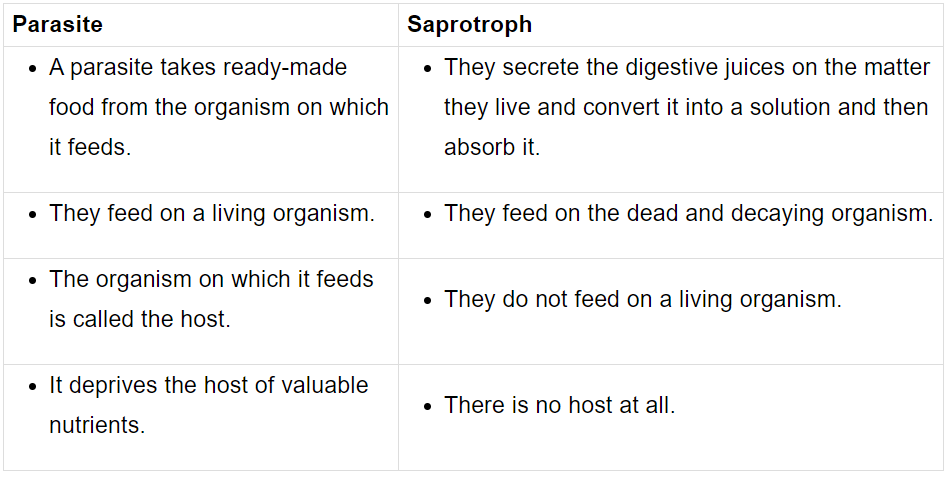Class 7 Science Chapter 1 Question Answers - Nutrition in Plants
Q 1. Why do organisms need to take food?
Food is required by all living organisms mainly for four reasons or purposes:
- Food helps a living organism to grow. If enough food is not given or if, the food given is not of the right kind, the organism will not have proper growth.
- Another important function of food is to provide energy which is required for any living organism for movements and other activities.
Food
- Food is also needed by living organisms for the replacement and repairing of their damaged parts.
- Food provides us with the power to fight against infections and diseases.
Q 2. Distinguish between a parasite and a saprotroph.
Fungi: Saprophyte
Q 3. How would you test the presence of starch on leaves?
The presence of starch on leaves can be tested by Iodine Test. Iodine turns starch solution blue.
Q 4. Give a brief description of the process of synthesis of food in green plants.
Leaves have a green pigment called chlorophyll. In presence of sunlight, they use carbon dioxide and water to synthesize carbohydrate. During this process, oxygen is released. The carbohydrates ultimately get converted into starch.
Carbon dioxide from air is taken through stomata. Water and minerals are absorbed by roots and transported to leaves.
Q 5. Fill in the blanks:
1. Green plants are called _______ since they synthesize their own food.
Autotrophs
2. The foods synthesized by the plants are stored as _______.
Starch
3. In photosynthesis solar energy is captured by the pigment called ______.
Chlorophyll
4. During photosynthesis plants take in ____________ and release ______.
Carbon dioxide, oxygen
Q 6. Name the following:
1. A parasitic plant with yellow, slender, tubular stem.
Cascuta
2. A plant that has both autotrophic and heterotrophic mode of nutrition.
Insectivorous plants
Insectivorious Plant
3. The pores through which leaves exchange gases.
Stomata
Q 7. Tick the correct answer:
(i) Amarbel is an example of -
(a) Autotroph
(b) Parasite
(c) Saprotroph
(d) Host
Correct Answer is Option (b)
Parasites are an incredibly varied group of organisms that live within host cells. They are smaller than their host organism and reproduce faster by causing more damage to the host. They receive all sorts of benefits like food and shelter from the host.
(ii) The plant which traps and feeds on insects is -
(a) Cuscuta
(b) China rose
(c) Pitcher plant
(d) Rose
Correct Answer is Option (c)
The plant that catches insects and feeds on them is the pitcher plant. The numerous carnivorous plants in the pitcher plants are changed to set traps identified as pitfall traps.
Pitcher Plant
Q 8. Match the items in column I with those in column II:
Q 9. Mark “T” if the statement is true and “F” if it is false:
1. Carbon dioxide is released during photosynthesis.
False
2. Plants which synthesize their food themselves are called saprotroph.
False
3. The product of photosynthesis is not a protein.
True
4. Solar energy is converted into chemical energy during photosynthesis.
True
Q 10. Choose the correct option in the following:
Which part of the plant gets carbon dioxide from the air for photosynthesis?
(a) Root hair
(b) Stomata
(c) Leaf veins
(d) Sepals
Correct Answer is Option (b)
Stomata are holes made from spaces between special cells. These holes are where plants absorb carbon dioxide from the air. Once inside the leaf, the carbon dioxide can enter plant cells. Inside the plant cells are special cell parts called chloroplasts, where photosynthesis takes place.
Q 11. Which is the correct option in the following:
Plants take carbon dioxide from the atmosphere mainly through their
(a) Roots
(b) Stem
(c) Flowers
(d) Leaves
Correct Answer is Option (d)
Atmospheric carbon dioxide enters plants mainly through the pores in the leaves called stomata during photosynthesis.
|
26 videos|32 docs|9 tests
|
FAQs on Class 7 Science Chapter 1 Question Answers - Nutrition in Plants
| 1. What is nutrition in plants? |  |
| 2. What are the types of nutrition in plants? |  |
| 3. What are the essential nutrients required by plants for their growth and development? |  |
| 4. How do plants absorb nutrients from the soil? |  |
| 5. What is photosynthesis, and how does it contribute to plant nutrition? |  |
























